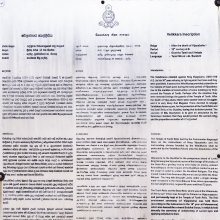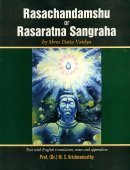Collyrium: 1 definition
Introduction:
Collyrium means something in Hinduism, Sanskrit. If you want to know the exact meaning, history, etymology or English translation of this term then check out the descriptions on this page. Add your comment or reference to a book if you want to contribute to this summary article.
Images (photo gallery)
In Hinduism
Yoga (school of philosophy)
Source: ORA: Amanaska (king of all yogas): A Critical Edition and Annotated Translation by Jason BirchCollyrium (i.e., “occult eye-collyrium”) refers to one of the boons (granted by Aghorī), forming part of the powers granted to one following certain Yoga practices, according to the Brahmayāmala-tantra (or Picumata), an early 7th century Śaiva text consisting of twelve-thousand verses.—Accordingly, [while describing a haṭha-sādhana (foreceful practice)]: “[When the Sādhaka] remains [in the hole] for up to one day, he is freed from all sins. [...] On the eighth day, the Sādhaka sees the shadow of Aghorī. Thus content, she gives [a boon, saying to the Sādhaka], ‘Good, my dear! Choose a boon: either lord of the earth, immortality, levitation, [entry into the] netherworlds, coming and going through the sky, invisibility, the elixir of mercury, the wish-fulfilling gem, the [magical] sword, the [seven-league] sandals or the [occult] eye collyrium (locana-añjana) [...]’ [...]”

Yoga is originally considered a branch of Hindu philosophy (astika), but both ancient and modern Yoga combine the physical, mental and spiritual. Yoga teaches various physical techniques also known as āsanas (postures), used for various purposes (eg., meditation, contemplation, relaxation).
See also (Relevant definitions)
Query error!
Full-text (+511): Anjana, Kajjala, Rasanjana, Bhinnanjana, Tryanjana, Nilanjana, Sauviranjana, Pushpanjana, Agnisara, Darvika, Kusumanjana, Tuttha, Cakshushya, Jalambala, Netraranjana, Srotonjana, Amritasanga, Paushpaka, Kulattha, Anjani.
Relevant text
Search found 143 books and stories containing Collyrium, Collyriums, Collyriumit; (plurals include: Collyriums, Collyriumses, Collyriumits). You can also click to the full overview containing English textual excerpts. Below are direct links for the most relevant articles:
World Journal of Pharmaceutical Research
Anjana a natural approach to treating eye disordersandquot; – review article < [2023: Volume 12, June special issue 10]
Ayurvedic prevention of mucormycosis via Anjana application: Review < [2021: Volume 10, August issue 10]
Role of panchakarma in agadtantra < [2019: Volume 8, February issue 2]
Netra darpanamu - A Unique book on eye diseases < [Volume 27 (issue 2), Oct-Dec 2007]
Historical use of perfumes in ancient Indian literature. < [Volume 28 (issue 2), Oct-Dec 2008]
The need to publish well-edited tamil medical texts < [Volume 14 (issue 3), Jan-Mar 1995]
Charaka Samhita (English translation) (by Shree Gulabkunverba Ayurvedic Society)
Chapter 9 - The therapeutics of Insanity (unmada-cikitsa) < [Cikitsasthana (Cikitsa Sthana) — Section on Therapeutics]
Chapter 10 - The therapeutics of Epilepsy (apasmara-cikitsa) < [Cikitsasthana (Cikitsa Sthana) — Section on Therapeutics]
Chapter 5 - Measure in eating (matrashita) < [Sutrasthana (Sutra Sthana) — General Principles]
Journal of Ayurveda and Integrative Medicine
Ayurvedic management central serous retinopathy - A case report < [Volume 14 (issue 5), Sep-Oct 2023]
Review of unique ophthalmic formulations in Kerala Ayurveda < [Volume 13 (issue 2), Apr-Jun 2022]
Efficacy of Mathulungadi Nasyam in preventing COVID-19: A study < [Volume 13 (issue 3), Jul-Sep 2022]
International Ayurvedic Medical Journal
Conceptual view of nasya (nasal medication) in poisoning < [2017, Issue VII, July]
Understanding the role of anjana in present era – a review study < [2020, Issue 4, April]
Vishaghna yogas in charak samhita – a review < [2018, Issue VIII, August]
Cosmetics, Costumes and Ornaments in Ancient India (by Remadevi. O.)
2.2. Pharmaceutical use of Añjana (Collyrium) < [Chapter 1 - Cosmetics]
3.6. Ornamental Painting < [Chapter 1 - Cosmetics]
1.2. Materials (c): Padmarāga (Ruby) < [Chapter 3 - Ornaments]
Related products

